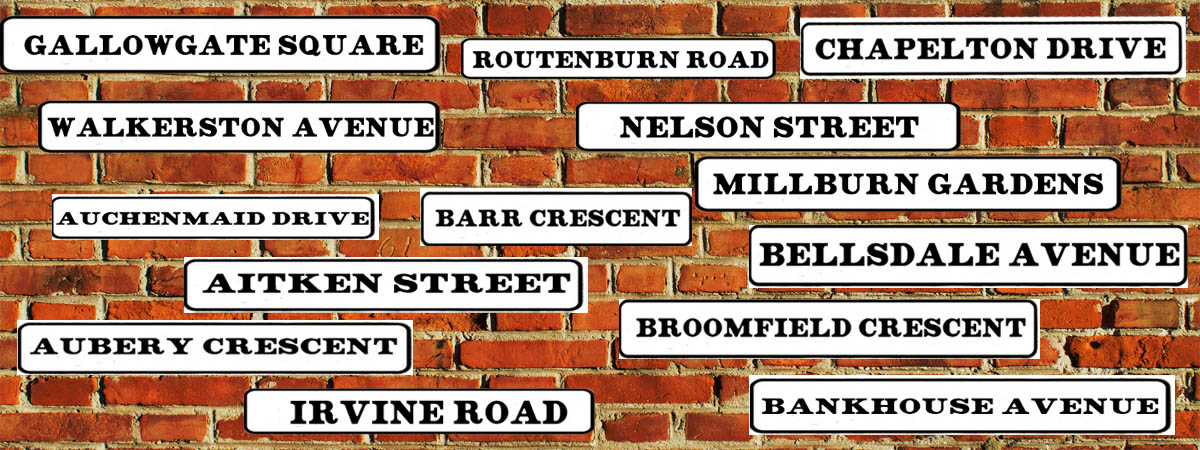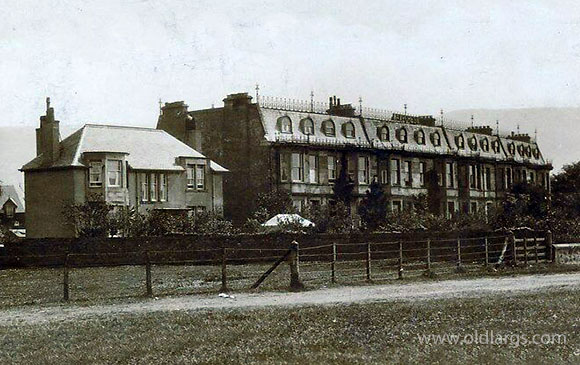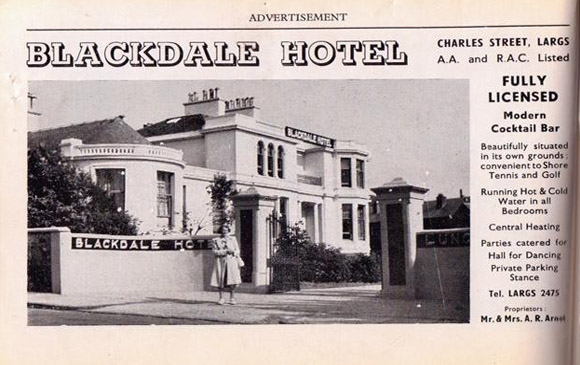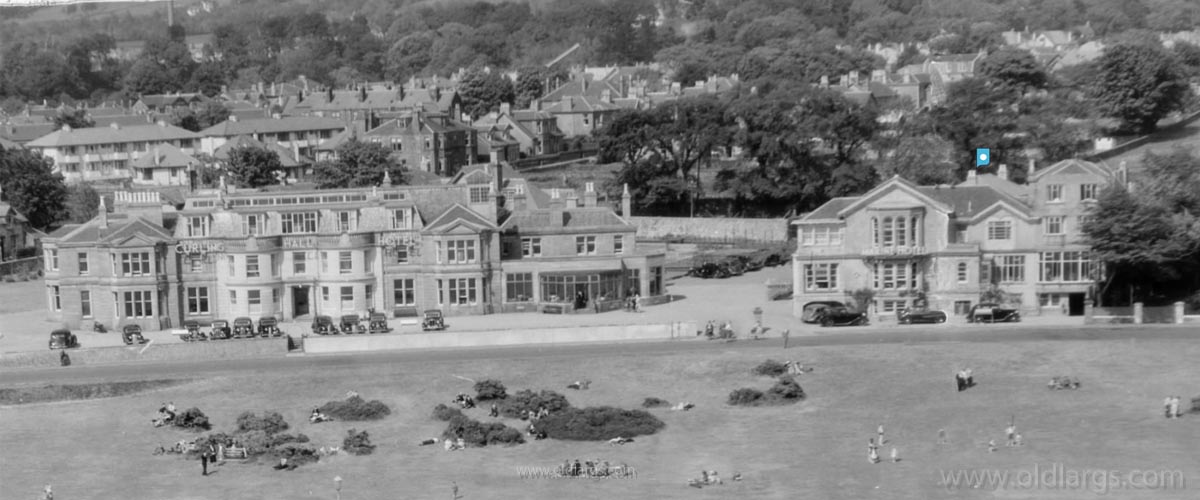
Aitken Street
Previously known as Pyper Row. Named after the first Provost of Largs between 1876 and 1878, Mr Robert Aitken
Aubery Crescent
Named after the daughter of Captain John William Brisbane, Miss Charlotte Aubery Arethusa Brisbane. Miss Brisbane’s third surname , Arethusa is from her grandfather Sir Charles Brisbane's ship HMS Arethusa which he commanded from 1805 to 1808. It was in the HMS Arethusa in 1807 that he captured the island of Curacao from the Dutch which earned him a knighthood.
In the past the area was also called Aubery land or Fishermans house. The house’s at Aubery were apparently erected very quickly in the 1870s when the railway line was expected to be extended Southwards from Wemyss Bay.

Auchenmaid Drive
Named after Auchenmaid Craigs a rocky outcrop about 310m high which lies to the East of the town.
Bankhouse
Bankhouse Avenue, Crescent and Grove are all named after the large house called Bankhouse which sits at the top of Bankhouse Avenue.
Bankhouse was built for the Scott family of Halkshill. In 1930 it was bought by Mr David Lang a paisley builder. He lived in the house and built a number of bungalows which became Bankhouse Avenue and Crescent.
Barr Crescent
Named after Mr Robert Barr who made fortunes in whiskey and shipping. He bought the land and organised the road and new houses to be built.
Bellmans Close
Also known as Manse or Kirk Close. This close was where the bellman or town crier once lived.
Bellsdale Avenue
Named after a Mr Bell who was head keeper to the Halkshill estate. Around 1920 Mr Bell lived in Hillside cottage and was given a field as part of his wages. The field became Bellsdale.
Blackdales Avenue
Build on the grounds of Blackdales House on Charles Street. Grand houses started to appear in Charles Street by 1828.
The most prominent at that time was Blackdales. Various owners altered the house over the years and by 1925 it had over 18 rooms, stabling, coachman’s house and garage. It was once owned by the court photographer John Fergus around 1876 which he used as his home and studio. Later it became the Charleston Hotel and is now flats.

Boathouse Avenue
Boathouse Avenue, Drive and Road were streets built close to a boathouse which belonged to Mount Stewarts of Bute.
Boyd Street
An 1905 edition of the Largs and Millport news states that this street was named after a Mr Boyd of Tron.
Brisbane Crescent, Brisbane Glen, Brisbane Road and Brisbane Street
All named after Sir Thomas Makdoughall Brisbane.
Thomas Brisbane, son of Sir Thomas Brisbane and Dame Eleanora Brisbane, was born at Brisbane House Largs in 1773. He received a good general education at the University of Edinburgh before taking up a commission in the army at the age of 17. He saw active service in both Europe and the West Indies. After one disastrous Atlantic crossing with his regiment in 1795 his ship ended up off the coast of Africa rather than the West Indies.
As a result, Brisbane resolved to learn more about astronomy so he could navigate at sea. Whilst on temporary leave from the army between 1805 and 1811, he built an observatory at Brisbane House in 1808, which was only the second one in Scotland at the time. His interest in astronomy became a lifelong pursuit, and his subsequent observations and studies made a significant contribution to the advances in navigation which took place over the next hundred years.In November 1819 he married Anna Maria Hay Makdougall of Makerstoun, Roxburghshire, Scotland. On his father-in-law's death, Brisbane assumed the additional surname becoming Makdougall Brisbane.
At the end of the Napoleonic Wars he sought employment which would allow him to continue his interest in astronomy and navigation. The new Sir Thomas Brisbane became the 6th Governor of New South Wales in 1821 and he immediately set about establishing a private observatory in the grounds of Government house at Parranatta, using much of the equipment from his Largs observatory. The town of Brisbane, the Brisbane River, and the Sir Thomas Brisbane Planetarium were all named after him. Brisbane left Australia in December 1825 and returned to Largs. He settled down to the life of a country gentleman and took an interest in his estate, his regiment and astronomy.Broomfield
Broomfeild Crescent and Place named after the Broomfields.
Buchanan Street
Named after Mr Dugald Buchanan, born 1825. He lived in the house Craigneish.
The house still stands and the street was originally the driveway of the house.
Burnside Road
Named after Burnside House which was built in 1876. This later became the Hills Hotel and later the Scottish National Sport Centre.
Castlehill Drive
Takes its name from Castle Hill, the hill which Cock ma lane stands on. An Iron Age fort on the summit of the Castle Hill about 60m in diameter. Traces of the rampart and ditch still exist and that of the entrance. A winding approach is also visible.
Cathcart Road
Named after Charles John Cathcart who gifted land at Haylie for Douglas Park to be created in 1906. Later in 1920 he donated additional land which allowed the creation of the bowling and tennis courts.
Chapelton Drive
Chapelton Drive and Way are named after Chapelton Farm.
Charles Street and John Street
Charles Street and John Street were named after Charles May and John Hill.
Anthony Road, Charles Street and John Street were originally known as "long closes"
Cunningham Drive
Cunningham Drive was named after Charles Cunningham Scott of Hawkhill, Largs. Born 28th December, 1794. Died 27th October, 1875.
Charles Cunningham Scott was the great grandson of John Scott who founded ‘Scotts’ shipbuilding at Greenock in 1711. In later generations of Scott’s, the name of his estate changed from Hawkhill to Halkshill.
Curlinghall
Named after the old Marine and Curlinghall Hotel. This hotel was a very popular hotel for visitors and holiday makers throughout the 1930s and up to the early 1980s. It started as two separate buildings being The Barra House and the Curling Hall.
The original Curlinghall was built by Dr John Cairnie in 1813 and was one of the first large mansions to be built in Largs. Dr Cairnie was from Glasgow and was a retired surgeon from the East India Company. He lost his left arm in a gunpowder explosion but remained an enthusiastic curler. Dr Cairnie was the founder and first president of the Royal Caledonian Curling Club. He made Scotland's first artificial curling pond at Curling Hall. It was a pavement of finely dressed freestone three inches below ground level and flushed with a little water when frost was approaching. Dr Carine was very proud of his rink and if the wind caused the ice to be rough he would employ two joiners from Largs to plane the ice smooth. Read the full history of the Curlinghall Hotel at our Walk from Bath Street to the Pencil historical guide. Click here to go to the article now.

